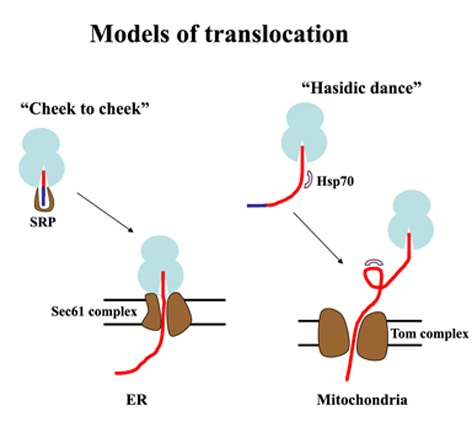Research
Our major interests are in subcellular targeting, translocation across membranes, folding and subcellular distribution of proteins in yeast as a model for eukaryotic cells. In particular we are interested in phenomena of dual targeting and localization of proteins. To this end we have developed experimental approaches which allow physical and functional detection of dual targeted proteins that are being applied as genome wide screens.

The following are a number of topics under our investigation:
Reverse translocation: Single translation products of the FUM1 and ACO1 genes (encoding TCA cycle enzymes fumarase and aconitase) are distributed between mitochondrial and cytosolic subcellular locations. The data in vitro and in vivo indicate that partial insertion of the polypeptide chains across the mitochondrial membranes, is followed by retrograde movement of the processed protein back through the translocation pore into the cytosol. Our model, suggests that distribution involves rapid folding (outside mitochondria) which provides the driving force for this retrograde movement.

Translation coupled import: Fumarase represents proteins that cannot be imported into mitochondria after the termination of translation (post-translationally). Fast acquisition of the folded state renders fumarase precursors incompetent for translocation after completion of translation. We have recently found that mitochondrially attached polysomes are enriched for the FUM1 message in comparison to free polysomes. Nevertheless, cytosolic exposure of the fumarase nascent chain depends on both translocation and translation rates, indicating that import of fumarase into mitochondria occurs while the ribosome is still attached to the nascent chain.

Eclipsed distribution: A phenomenon of highly uneven isoenzyme distribution was recently observed and termed 'eclipsed distribution'. In these cases, the amount of one of the isoenzymes, in one of the locations, is significantly minute and its detection by standard biochemical and visualization methods is masked by the presence of the dominant isoenzyme. Since detecting eclipsed distribution is difficult we assume that this phenomenon is probably much more common than currently recorded. Hence, developing new methods for localization and functional detection of eclipsed proteins is a challenge of our cell biology research.
Other projects include: (i) Distribution of fumarase and its function in human cells, (ii), Dual targeting mechanism of NFS1 and other proteins in yeast, (iii) Secretion of proteins and organic acid production in pathogenic fungi, and (iv) Metabolic engineering of organic acid production in yeast.

